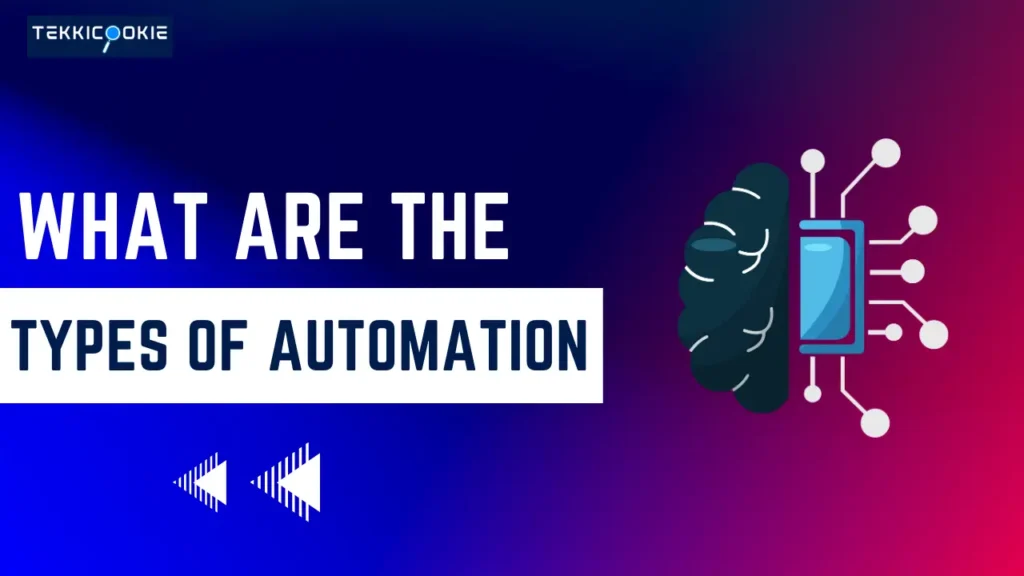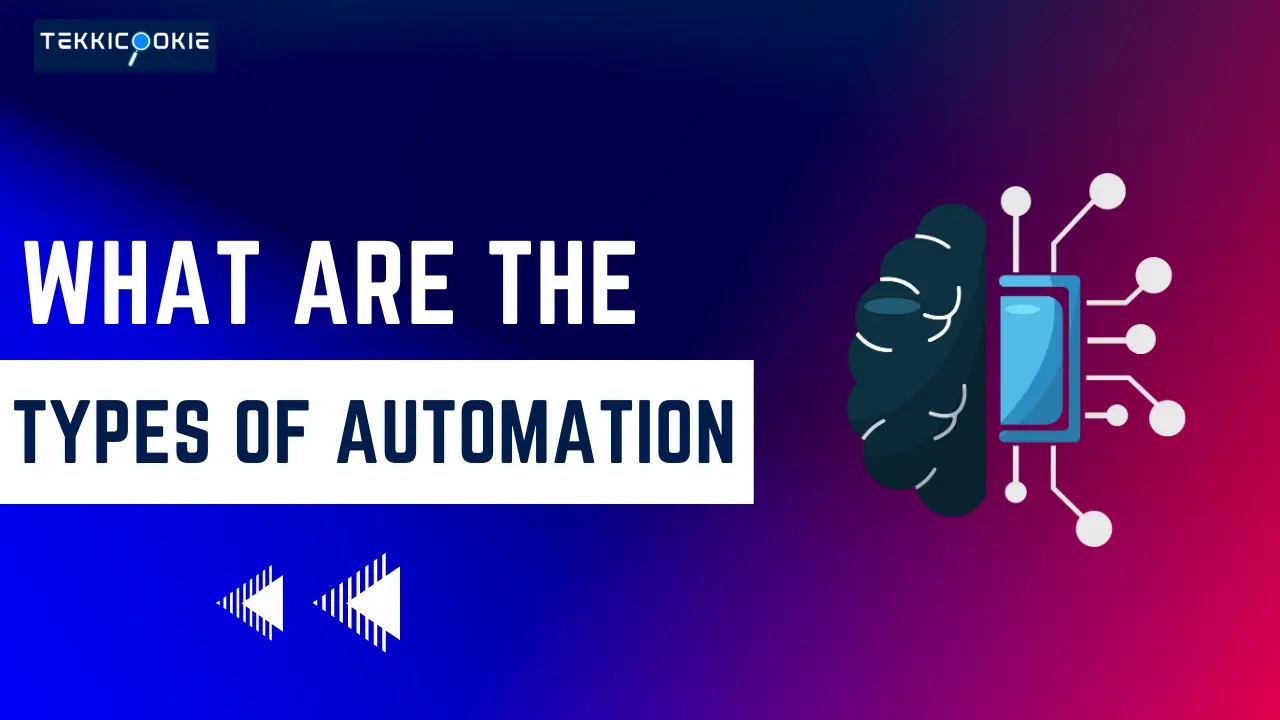Automation has become an integral part of various industries, revolutionizing the way we work and enhancing efficiency. By leveraging technology and eliminating manual tasks, automation streamlines processes and allows businesses to operate more effectively. In this article, we will explore the different types of automation and their applications across various sectors.

Industrial Automation
The use of technology and control systems to automate production operations is referred to as industrial automation. It plays a crucial role in improving productivity, quality, and safety within industrial settings. Industrial automation is classified into three types:
1. Fixed Automation
Using specialised technology or equipment to continuously carry out a certain activity is known as fixed automation, sometimes referred to as hard automation. It is suitable for high-volume production processes with consistent requirements. Examples include assembly lines in automobile manufacturing or bottling plants.
2. Programmable Automation
Programmable automation allows for greater flexibility by utilizing computerized control systems. It enables the reprogramming of machines or robots to perform different tasks as needed. This type of automation is commonly found in industries with moderate production volumes and frequent product changes, such as electronics manufacturing.
3. Flexible Automation
Flexible automation combines the advantages of fixed and programmable automation. It utilizes advanced robotics and computerized systems to handle a variety of tasks with minimal human intervention. Flexible automation is ideal for industries that require high customization or frequent product changes, such as consumer electronics or pharmaceuticals.
Robotic Process Automation (RPA)
Robotic Process Automation, or RPA, involves the use of software robots or bots to automate repetitive and rule-based tasks within business processes. RPA mimics human interactions with digital systems and applications, enabling organizations to streamline operations. The benefits of RPA include:
1. Increased Efficiency and Accuracy
RPA eliminates manual errors and significantly reduces the time required to complete routine tasks. Bots can work around the clock, ensuring consistent and accurate results. This efficiency allows employees to focus on more value-added activities.
2. Cost Savings
By automating repetitive tasks, organizations can achieve cost savings through reduced labour requirements. RPA also minimizes the risk of errors, leading to fewer costly mistakes and rework.
3. Enhanced Scalability
RPA provides scalability, allowing businesses to handle increased volumes without significant resource investments. As workloads fluctuate, organizations can easily scale up or down their automation capabilities.
Artificial Intelligence (AI) Automation
Artificial Intelligence automation leverages advanced algorithms and machine learning capabilities to enable systems to learn from data and make intelligent decisions. There are several types of AI automation:
1. Machine Learning
Machine learning involves training algorithms to recognize patterns and make predictions based on data. This type of AI automation finds applications in various fields, such as customer sentiment analysis, fraud detection, and predictive maintenance.
2. Natural Language Processing
Natural Language Processing (NLP) is the process through which computers can understand and translate human language. NLP automation powers chatbots, virtual assistants, and voice recognition systems, enhancing customer service and improving user experiences.
3. Computer Vision
Computer vision enables machines to understand and interpret visual information from images or videos. This type of AI automation finds applications in autonomous vehicles, facial recognition systems, and quality control inspections.
Internet of Things (IoT) Automation
The Internet of Things (IoT) refers to the network of interconnected devices that can collect and exchange data. IoT automation involves integrating devices and systems to automate processes. Some examples of IoT automation include:
1. Smart Homes and Buildings
IoT automation enables homeowners to control various aspects of their homes, such as lighting, temperature, security, and appliances, through interconnected devices and smartphone applications.
2. Industrial IoT
Industrial IoT automation optimizes processes in manufacturing, logistics, and energy management. By connecting machines, sensors, and analytics platforms, organizations can achieve real-time monitoring, predictive maintenance, and improved efficiency.
3. Healthcare and Wearables
IoT automation in healthcare allows for remote patient monitoring, efficient inventory management, and enhanced medical device integration. Wearable devices, such as fitness trackers and health monitors, collect data and provide personalized insights.
Process Automation
Process automation involves automating the sequence of steps within a business process to improve efficiency and reduce human error. There are different approaches to process automation:
1. Business Process Automation (BPA)
BPA involves automating end-to-end business processes by integrating systems, applications, and data. It eliminates manual handoffs, reduces paperwork, and ensures smoother collaboration between departments.
2. Robotic Process Automation (RPA)
As mentioned earlier, RPA focuses on automating repetitive and rule-based tasks, typically within a single application or system. RPA bots interact with user interfaces to perform tasks like data entry, report generation, and data validation.
3. Workflow Automation
Workflow automation streamlines the flow of tasks and information between individuals and systems, ensuring efficient coordination and timely completion of activities. It can involve routing approvals, triggering notifications, or integrating systems for seamless data transfer.
Test Automation
Test automation involves using software tools and frameworks to automate the execution of test cases and verify the functionality of software applications. Test automation offers numerous benefits:
1. Increased Efficiency and Speed
Automated tests can be executed much faster than manual tests, allowing for quicker feedback on software quality. This speed helps organizations to accelerate their software delivery cycles.
2. Improved Accuracy
Automated tests follow predefined steps and are not prone to human errors or inconsistencies. They provide accurate results and help ensure that software meets the desired quality standards.
3. Cost Savings and Resource Optimization
By automating repetitive testing tasks, organizations can reduce the time and effort required for testing activities. This optimization allows teams to focus on more complex and critical areas, leading to overall cost savings.
Home Automation
Home automation involves the integration of smart devices and systems to control and monitor various aspects of a home. Home automation systems are classified into numerous types:
1. Security and Surveillance Automation
Home automation enables homeowners to monitor and control security systems, access controls, and surveillance cameras remotely. It enhances home safety and provides peace of mind.
2. Energy Management Automation
Energy management automation allows homeowners to optimize energy consumption by controlling lighting, heating, ventilation, and air conditioning (HVAC) systems. Smart thermostats and energy monitoring devices help reduce energy waste and lower utility bills.
3. Entertainment and Comfort Automation
Home automation systems can automate entertainment systems, such as audiovisual equipment and home theatres. Additionally, they offer convenience by automating tasks like opening and closing blinds or adjusting ambient lighting.
Read More: What is Home Automation Useful For?
Supply Chain Automation
Automation in supply chain management has become crucial for organizations seeking efficiency and competitiveness. It encompasses various types of automation:
1. Warehouse Automation
Warehouse automation involves the use of technologies like robotics, automated storage and retrieval systems (AS/RS), and barcode scanning to optimize warehouse operations. It includes tasks such as inventory management, order picking, and goods sorting.
2. Inventory Management Automation
Automated inventory management systems leverage technologies like RFID (Radio Frequency Identification) and barcode scanning to track and manage inventory levels in real time. This automation ensures accurate stock control, reduces manual counting errors, and minimizes stockouts.
3. Demand Forecasting and Planning Automation
Automation in demand forecasting and planning utilizes advanced algorithms and analytics to analyze historical data, market trends, and other factors to predict future demand. This automation helps organizations optimize inventory levels, production, and supply chain logistics.
Healthcare Automation
Automation plays a significant role in enhancing efficiency, accuracy, and patient care within the healthcare industry. Here are a few types of healthcare automation:
1. Electronic Health Records (EHR) Automation
EHR automation digitizes patient records, making them easily accessible to healthcare providers and improving the accuracy and efficiency of medical documentation. It allows for seamless data sharing, decision support, and automated reminders for patient care.
2. Medical Imaging Automation
Automation in medical imaging, such as radiology and diagnostic imaging, utilizes AI algorithms to analyze medical images for abnormalities or signs of diseases. This automation aids in accurate diagnosis, faster image interpretation, and improved patient outcomes.
3. Robotic Surgery
Robotic surgery involves the use of robotic systems to assist surgeons in performing complex procedures with precision and minimal invasiveness. Robotic arms and instruments offer enhanced dexterity, visualization, and surgical control, leading to better patient outcomes.
Conclusion
Automation has become an essential part of modern society, transforming industries and revolutionizing the way we live and work.
From industrial automation to RPA, AI, IoT, and various other forms of automation, businesses and individuals can benefit from increased efficiency, accuracy, and cost savings.
By embracing automation, organizations can stay competitive, streamline processes, and focus on higher-value activities, ultimately leading to improved productivity and success in the digital age.
